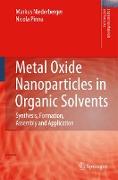- Start
- Metal Oxide Nanoparticles in Organic Solvents
Metal Oxide Nanoparticles in Organic Solvents
Angebote / Angebote:
The synthesis of nanoparticles with control over particle size, shape, and crystalline structure, has long been one of the main objectives in chemistry – and yet these materials are only beginning to be used in nanotechnology. Metal oxides play a significant role in many fields of technology including catalysis, sensing, energy storage and conversion, and electroceramics. It is expected that they could show enhanced or even new properties at the nanoscale. Metal Oxide Nanoparticles in Organic Solvents discusses recent advances in the chemistry involved for the controlled synthesis and assembly of metal oxide nanoparticles, the characterizations required by such nanoobjects, and their size and shape depending properties.
Innovative strategies have to be developed to allow good control from the molecular precursor to the final product at low processing temperatures. In the last few years, a valuable alternative to the well-known aqueous sol-gel processes was developed in the form of nonaqueous solution routes, which can roughly be divided into two methodologies, namely surfactant- and solvent-controlled preparation routes. Metal Oxide Nanoparticles in Organic Solvents reviews and compares surfactant- and solvent-controlled routes, as well as providing an overview of the most important techniques for the characterization of metal oxide nanoparticles, crystallization pathways, the physical properties of metal oxide nanoparticles, their applications in diverse fields of technology, and their assembly into larger nano- and mesostructures.
Researchers and postgraduates in the fields of nanomaterials and sol-gel chemistry will appreciate this book’s informative approach to chemical formation mechanisms in relation to metal oxides.
Folgt in ca. 15 Arbeitstagen
